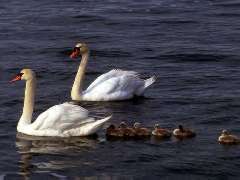Overview
 Order: Anseriformes
Order: Anseriformes
Family: Anatidae
Species: Cygnus olor
IUCN Status: Least Concern
Population trend: increasing
Distribution: found throughout the UK. Also in a few areas across northern Europe, eastwards to Mongolia. Introduced to North America, South Africa, Australia and New Zealand.
Habitat: large freshwater areas, such as rivers, lakes and canals. Also estuaries, especially in winter.
Description: adults all white; young are grey to begin with, and develop brown feathers which they keep until their second year. Reddish-orange bill, with a black knob of skin at the base.
Size: length:- 1.5m. Wingspan:- 2.25m. Weight:- male, 10kg, female, 8kg.
Life-span: most swans do not live more than 7 years in the wild. They can live up to 50 years.
Food: underwater plants, grasses and cereal crops.
Read More: Appearance
